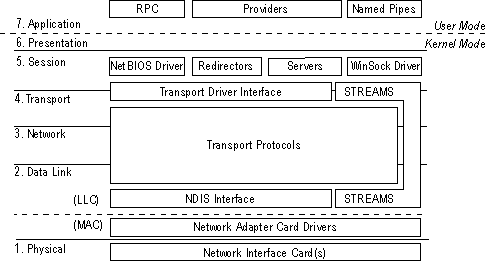
A significant difference between the Windows NT operating system and other operating systems is that the networking capabilities were built into the system from the ground up. With MS-DOS, Windows 3.x, and OS/2, networking was added to the operating system.
By providing both client and server capabilities, a computer running Windows NT Server or Windows NT Workstation can be either a client or server in either a distributed-application environment or a peer-to-peer networking environment.
The following illustration shows the specific way Windows NT implements the OSI model.

Figure 1.9 Windows NT layered network architecture
To understand the Windows NT operating system capabilities, it is important to understand the network architecture. The networking architecture with its layered organization provides expandability by allowing other functions and services to be added.
The rest of the chapter is devoted to an explanation of the concepts and features of the Windows NT layered networking architecture, including the following topics.